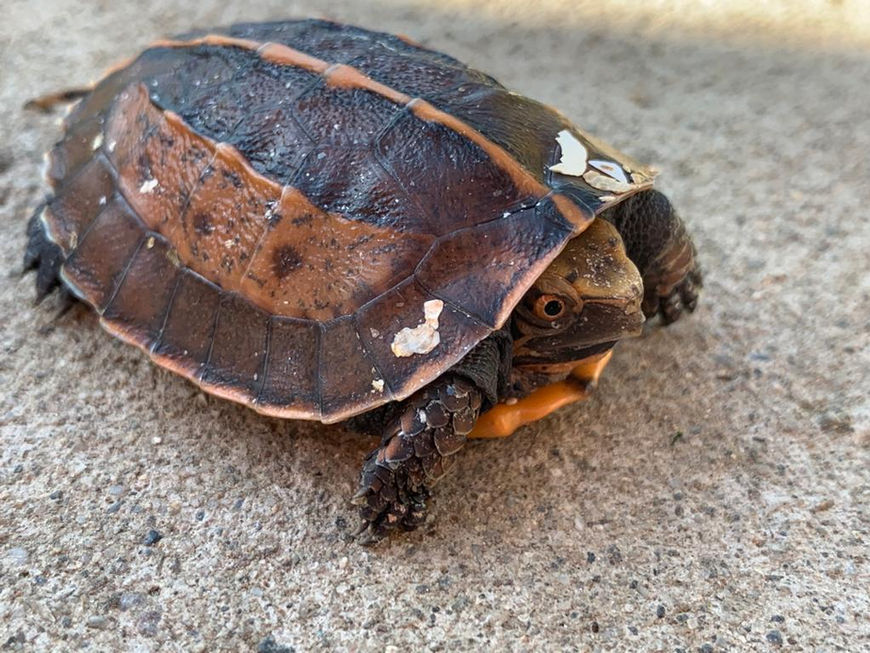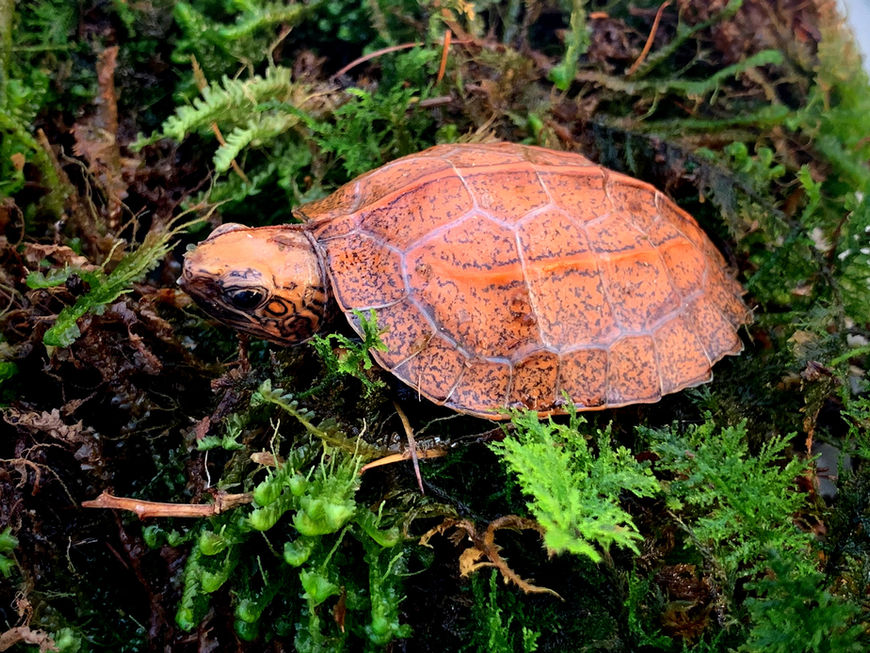top of page

© Cuora.org
Cuora Hybrids
Cuora "serrata" (Iverson & Mccord 1992)
Cuora species are readily able to hybridise, although this is rare in the wild due to allopatric habitat, geographic distributions, etc., there is one marked exception:
Cuora bourreti/C. galbinifrons/C. picturata share their habitats and ranges with C. mouhotii at certain elevation levels, essentially zones of overlap. While the former three species are usually found at elevations of 500 m ASL, Cuora mouhotii generally prefers lower elevation habitats. However, within a narrow elevational boundary zone the two species co-occur, and do hybridise. The resultant offspring are fully fertile and can mate with either parent species, as well as with other hybrids. These hybrids became apparent in the turtle trade during the 1980's. Interestingly, due to the hybrids' unique appearance, along with science's lack of certain modern genetic tecniques and the assumption that hybridisation among separate genera (back then, C. mouhotii was considered to belong in another genus: Pyxidea) was extremely unlikely and would lead to infertile offspring, the Cuora hybrids were subsequently described by Iverson & Mccord in 1992 as C. galbinifrons serrata, and later even elevated to full species status, i.e. Cuora serrata, by Fritz & Obst in 1997. However, by 2004, Stuart et al. used new molecular techniques to show that C. serrata was in fact the a hybrid - not a species or subspecies at all. Since then we have learned via genetics and surveys of many Chinese farms and markets, that hybridisation is commonplace in geoemydids. However, "C. serrata" specimens appeared much rarer in the trade in the 1980's despite intense collection, than they appeared later in the early 2000's. The reason for this pattern of "reversed abundance" is unclear. One hypothesis is that once populations of the two parental species crashed in many areas (from over-collection beginning in the late 1980s-1990s), they became more likely to mate with related species in the same habitat. As we know now, many species that we regard as such show multiple levels of intogression from related species.
"C. serrata" specimens are variable in appearance, especially depending on which parent species is involved and which of the two involved species is mother and father. Most first generation "C. serrata" have a C. mouhotii sire, which can be explained by the generally more aggressive mating behaviour in this species compared to
C. bourreti/C. galbinifrons/C. picturata. The carapace shape in this cross is dominated by the maternal lineage, and the coloration and pattern is a mix of both species. We maintain several "C. serrata" at our Center for research purposes - to better understand hybridisation in geoemydids. Our observations show that an accidental one-time mating of a C. mouhotii male to a C. galbinifrons female can facilitate production of "C. serrata" offspring by said female for three years in a row, supporting the popular hypothesis that Cuora have the ability for sperm storage. This first generation offspring have characters intermediate to both parents, and all match the previous description for hybrids. A "C. serrata" female mated to a C. mouhotii male produces about 50% "C. serrata" specimens and 50% C. mouhotii species; the latter can be hard to differentiate from pure C. mouhotii based on appearance. A "C. serrata" male and a "C. serrata" female mating produces intermediate offspring which look similar to each other and show consistency among and across cohorts, which would make confusing them for a true species an honest mistake.
The following Cuora x Cuora hybrids are currently known:
Cuora amboinensis x Cuora cyclornata (captivity & wild)
Cuora amboinensis x Cuora flavomarginata (captivity)
Cuora amboinensis x Cuora mouhotii (captivity & wild)
Cuora amboinensis x trifasciata (captivity but also in the Hong Kong wild, where released specimens of Cuora amboinensis hybridise with native Cuora trifasciata)
Cuora aurocapitata x Cuora cyclornata (captivity)
Cuora aurocapitata x Cuora pani (captivity)
Cuora aurocapitata x Cuora trifasciata (captivity)
Cuora aurocapitata x Cuora yunnanensis (captivity)
Cuora bourreti x Cuora cyclornata (captivity & wild)
Cuora bourreti x Cuora flavomarginata (captivity)
Cuora bourreti x Cuora galbinifrons (captivity & perhaps in intergradation zones in the wild)
Cuora bourreti x Cuora picturata (captivity & perhaps in intergradation zones in the wild)
Cuora cyclornata x Cuora flavomarginata (captivity)
Cuora cyclornata x Cuora galbinifrons (captivity & wild)
Cuora cyclornata x Cuora trifasciata (captivity but also in the Hong Kong wild, where released specimens of Cuora cyclornata hybridise with native Cuora trifasciata)
Cuora flavomarginata x Cuora galbinifrons (captivity)
Cuora flavomarginata x Cuora mccordi (captivity)
Cuora flavomarginata x Cuora mouhotii (captivity)
Cuora flavomarginata x Cuora trifasciata (captivity & wild)
Cuora mccordi x Cuora trifasciata (captivity & wild)
Cuora mouhotii x Cuora trifasciata (captivity & wild) = Cuora "shiui" - once planned to be described as this species.
Cuora pani x Cuora trifasciata (captivity)
Cuora pani x Cuora yunnanensis (captivity)
Cuora trifasciata x Cuora yunnanensis (captivity)
Cuora yunnanensis x Cuora zhoui (captivity)
Apart from this list, a wide range of Cuora x other geoemydid species are known, the most "famous" one being Mauremys "iversoni", a hybrid of Cuora trifasciata x Mauremys mutica; this will be described in a future post.
© Cuora.org
bottom of page

























